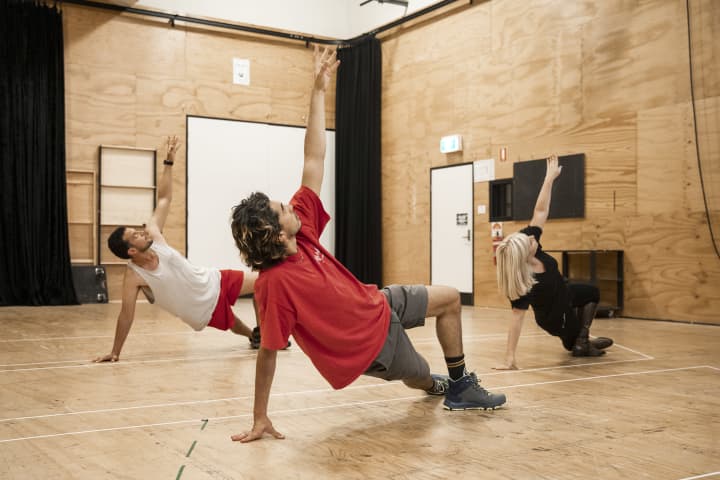Physiotherapist Annie Strauch is the founder of Performance Medicine, an expert physiotherapy practice and regular MTC collaborator, dedicated to looking after the physical health of performers and crew. Here, she offers insight into what her work involves as well as some at-home exercises for all of us, whether working from home or otherwise.
Strauch was always physically active as a child, as well as a fan of the theatre and other performing arts. She gravitated toward physiotherapy when she finished school and has never looked back. ‘I became a physiotherapist because I was fascinated by the human body and the amazing things that it could achieve in an athletic and creative sense,’ she says. ‘Shortly after graduating from Physiotherapy at La Trobe University (2003), I moved to London where I landed my dream job working in a practice that predominantly treated West End performers.’
It was there that she cut her teeth in the performing arts industry, working on over 30 West End productions, as well as for London’s Globe Theatre and even reality TV. ‘This work ignited a passion in me to assist production companies and performers find a way to put up the best work, night after night, in a safe and sustainable way for all the performers and backstage crew.’

Annie Strauch. Photo: Performance Medicine
Performers as elite athletes
It can be sometimes overlooked that actors, dancers and performers ‘are elite athletes’ and as such they ‘require the attention, care and specificity that any sporting code would demand’. It’s for this reason that Strauch founded Performance Medicine in 2010, after returning from England. In addition to daily physio and rehabilitation consultations, the team at Performance Medicine provide education and treatments across a range of disciplines, including targeted physio for actors, circus artists, dancers and vocal performers.
‘The nature of performing is that there is often a high load of intensive activity over a shorter period of time,’ she explains. ‘This begins with the rehearsal period, when many movements and actions are repeated as the actors, director and crew work the show. These often unfamiliar but repetitive movements can create muscular soreness so it’s important that the actor understands what is happening in their body and that they have a strategy to release and activate the area to “reset” the body for the next day or rehearsals.’
'Storm boy is a terrific example of assessing both the set and the puppets used in the show. The sand dune set had an undulating and random nature, which could have been difficult to work on, especially with props and low lighting.’
This care continues during a show’s season, both as a preventative measure but also in the unfortunate case of an accident. ‘Occasionally someone rolls their ankle (on or off the stage) or some choreographed movement doesn’t go to plan. For “regular people”, often the advice is to stop our activity all together. However, for a performer we will assess whether or not it’s safe for them to continue performing – it may be that we can alter some direction/choreography in the show so that they can still perform safely.’
Strauch has been working closely with MTC for over a decade, looking after our actors when required but also in ways you might not have expected. ‘What many may not appreciate is the planning that MTC puts into the show prior to the actors even getting into the rehearsal room – from the safety of the set design, the costume and prop fittings to the sustainability of the movement direction.’

Conor Lowe and puppeteer Ellen Bailey in Storm Boy. Photo: Jeff Busby
Revolves, sandy surfaces and puppets oh my!
The type of work she might be called on to provide is as varied as the shows we stage. A play on a revolve will require different movement and safety techniques to a play on a rake (angle), while those that require the cast to work with other unstable surfaces, such as the sand in Storm Boy, provide yet more challenges. Strauch will tailor workshops to the individual show to ensure cast and crew ‘have appropriate footwear, body strength and awareness of what the dangers may be when working in environments that are slippery or moving’. And working with puppets or similar props is another matter altogether!
‘Storm Boy is a terrific example of assessing both the set and the puppets used in the show. The sand dune set had an undulating and random nature, which could have been difficult to work on, especially with props and low lighting. The cast worked on crawling around the set to become as familiar as possible, and I developed balance exercises and leg strengthening exercises for them so that they could improve and maintain their body balance and strength.’
‘My role is to sometimes collaborate with the creative team about how we may be able to make costumes – such as corsets or heavy capes – more sustainable for the actor.’
In addition to the sandy stage, the pelican puppets had various modes of movement, triggers and handles, so Strauch also worked with the cast to teach them how to avoid unsustainable movements when lifting and moving the puppets that could have increased their risk of injury over the run of the show. ‘Upper body and core exercises were provided for the actors to maintain their strength and mobility,’ she explains.
Another show Strauch highlights is Richard III. ‘Richard (Ewen Leslie) was characterised to have a deformed gait, so Ewen, director Simon Phillips and I met at the beginning of the rehearsal period to develop the narrative of the character as well as a gait pattern that was in character and realistic, without creating issues for Ewen. We developed his warm up and cool down so that he could maintain his body during the demanding role. We also consulted on his costuming and how this could augment his physical characteristics.’
Yes, physiotherapists even consult on costumes! ‘The other aspect of my role is to sometimes collaborate with the creative team about how we may be able to make costumes – such as corsets or heavy capes – more sustainable for the actor,’ Strauch explains. ‘Costumes are also a terrific way to create an illusion for a character who may need to display a particular body trait, and by adding padding or changing seams this can add to the effect.’
Performer to public
While the core of Strauch’s work involves performers, she also treats general public clients and is committed to education on the importance of looking after your body, no matter what you do. ‘Exercise is medicine. Movement is medicine,’ she says. And ‘being intentional about exercise’ is even more important while we are mostly (still) stuck at home, and likely missing out on a lot of the incidental exercise we are used to.
‘Many of us are completing our work online, which means we are sitting or standing and looking at a device much of the day. Regular neck stretches, shoulder movements and upper back mobility exercises are particularly important to decrease the accumulation of tension in our body as the day goes on. Some form of movement every 15 to 20 minutes is recommended, and this can be as simple as standing up, marching on the spot or walking up and down the hallway.’
For more specific exercises for your neck and shoulders, Strauch has provided us with some short exercise clips on how you can minimise tension and pain:
Struach’s number one tip for everyone to take a 30-minute brisk walk, everyday. ‘Getting outside in the fresh air to walk, as brisk as you can make it, does a multitude of things. Not only are you moving your whole body and activating your muscles in your legs and upper body (think Kath & Kel from Kath & Kim), you are increasing weightbearing through the legs for bone health; you are increasing your cardiovascular fitness; and you are managing your stress hormones by producing endorphins and dopamine that will elevate your mood. So walking is a YES from me!’
Published on 24 June 2020





